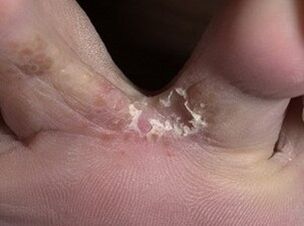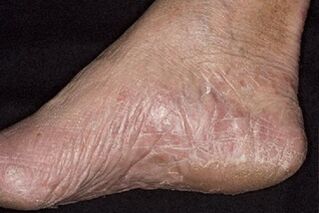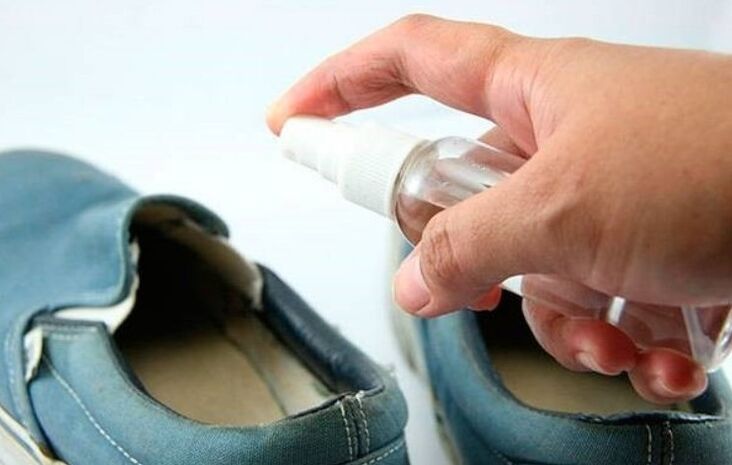Of all mycoses, mycoses (fungal lesions) of the skin of the feet are the most common. They are also called ringworm or Hong Kong's foot. About 30% of the population suffers from fungal diseases. Almost half of the patients never went to the doctor with them, spreading the fungus to loved ones. Microscopic pathogens can affect the dermis (skin) or nails. In the latter case, they speak of onychomycosis.
Why are the feet most commonly affected?
Various fungi are always present on the skin. Their reproduction is limited by good bacteria and skin secrets. If the immune work is violated, the composition of the microflora of the skin changes, a favorable opportunity arises for fungi - they can multiply freely. Infested entry doors can be damaged as regular:
- scratches;
- crack;
- friction.
Another cause of mycoses is endocrine disorders. If there is a malfunction in the work of the endocrine glands, not only the balance of hormones changes, but also the work of the entire organism. Including, the composition of skin secrets changes, so they lose their antiseptic properties. Fungi can feed on them, which also promotes reproduction.
Other factors also contribute to reduced protection:
- Digestive failure (malnutrition);
- vitamin deficiency;
- Excessive physical and psychoemotional stress;
- concussion;
- Often stressful.
All of these are nonspecific causes of fungal skin lesions. Due to them, mycosis of the feet, smooth skin on the body or mucous membranes may develop.
In addition, there are special types of fungi (Trichophyton or Microsporum) - pathogenic (pathogenic). When in contact with the skin or its surface, they can cause disease. In the case of feet, the disease is called erythromycosis. On the body, these pathogens form specific spots - lichens. You can be infected by people or animals.
The skin of the feet is a special place for fungi. There are always many keratinocytes. Microorganisms are used as housing and food. "Rampant" fungus causes sweaty feet. In closed shoes, a nutrient-rich moist environment is formed on the feet - every fungus' "dream". If a person neglects foot hygiene and does not dry and disinfect shoes, the infection will first multiply in them and then spread to the "owner"'s feet. Poor hygiene products, dry, synthetic socks also contribute to the spread of fungal infections.
Signs of fungus, visually apparent
Dermatomycosis is easier to treat and the earlier the disease is diagnosed. In advanced cases, treatment is long-term and includes medication and topical medications. In the initial stages of mycosis, the ointment can be dispensed with. It is important to be able to recognize the early symptoms of fungus so that you can seek medical attention promptly.
The appearance of the fungus depends on the form of mycosis. Fungal infections of the feet can occur in 3 different forms or in a mixed form - when signs of the three main variants appear on the legs at the same time.
Zhacha form

A type of athlete's foot that primarily affects the skin between the toes. The first symptom of the disease is a painful crack between the 3rd and 4th or 4th and 5th circle of the foot. Although the damage is small, it causes inconvenience when washing feet and walking.
If you examine the wound closely, you will notice a distinct white border around the wound (example in photo). This is what the edge of the skin looks like around the crack that has peeled off. Wounds can itch, ooze, aggravate, and vice versa - periodically heal and then reappear.
In some cases, the cracks heal, but the skin continues to peel off, hyperkeratosis (thickening of the dermis), corns and calluses develop. With an advanced form of rubbing, cracks become larger (example in the photo), appear between other fingers, and the skin keeps getting wet. Patients have difficulty walking around and wearing any shoes.

As this form progresses, the cracks increase in size. Similar signs appear on the second foot. Thick, large layers of skin fall off around the wound. The second (attached) end was not rejected and tried to remove the horny part with the end of the finger, which took additional damage to the foot.
This type of foot fungus is the most common. The pathological manifestations are initially not accompanied by any symptoms. Typically, the infection occurs between the 3rd and 4th fingers and does not change the color and structure of the skin until a certain point. Afterwards, wet cracks and layers of skin appear.
The feet themselves are unharmed, however, if the fungus is affected, the feet may sweat more than usual. The treatment of tricha fungus is characterized by moderate complexity.
hyperhidrosis form

With this form, the first sign of fungus on the skin is blisters on the arch of the foot. Mostly - near the heel. The surface dries out and a deep seal develops on it (feels like a nodule). Later, they visibly rise above the level of the skin as they fill with fluid. The vesicles (vesicles) are usually small - 2 to 5 mm in diameter. They can merge to form larger - bullae. Other symptoms include pain and itching around the rash.
Rupture of sweat blisters indicates the progression of the dyshidrotic form of mycosis. Instead, large or small erosions are formed. They usually become infected with bacteria and start to boil. The erosions do not heal for a long time, making walking painful. In some cases, the erosion disappears and is replaced by drying.
scaly

As the disease progresses, severe hyperkeratosis develops on the feet. The size and number of cracks increases. Most likely to bleed. This damage is the way for other pathogenic microorganisms to invade the body. As a result, the wound periodically becomes inflamed and can become abscessed. The most common form of foot fungus is manifested by increased dryness of the skin on the plantars of the extremities. This could mean that recently added fungi, or vice versa - are the result of other forms of development.
At the arch and center, the dermis becomes dry, thin, and shiny, covered with a web of wrinkles. In the area of the fingers and heels, hyperkeratosis - rapid keratosis, in which dead particles do not have time to fall off - is observed. Calluses or corns form on the front feet. There is a small crack on the heel. The entire surface is rough due to obvious flaking. Patients may experience itching. With the long-term development of mycosis, such symptoms are absent.
You can identify fungus on the legs by excessive dryness of the skin, bad smell, itching, and persistent peeling.
Onychomycosis
Onychomycosis is a foot (or palm) fungus that affects the appendages of the skin -- the nails. Nail fungus can be caused by the same pathogens that cause dermatophytosis. Mold and other types of simple fungus can get caught in the nail salon, on the beach, when trying on new shoes with bare feet, and when you go to the sauna or pool. Ingrown toenails may be a contributing factor. The thumb is most commonly affected.
When it hits the nail plate, the fungus begins to divide. It penetrates deep into the nail, spreading over its area. The first signs that can determine the fungus in the nails are loss of luster, the appearance of spots (white, yellow, brown, green), changes in the shape of the nail plate.
As the disease progresses, the structure of the nail changes (it thickens, becomes bumpy, loosens) in the discolored area.
Fungus on toenails looks like thick yellow growths. Affected nail plates are difficult to care for. Before each pruning, soak your feet in hot water. After exposure to water, the nails will soften and be easier to remove with manicure tools.
If the nail fungus is not treated, onycholysis begins - complete or partial detachment of the plate. Nails don't always grow back after residue is removed. Sometimes, the separation process ends with the nail falling off completely.
general principles of treatment

Fungus on the feet is treated with ointments, creams, solutions, special varnishes. At the same time, antifungal tablets are prescribed to the patient.
Throughout treatment, observe foot hygiene, cutting and sawing the affected area weekly. Every day, the patient must use a pedicure file to remove the layer of keratinocytes on the surface of the foot.
It's also important to take good care of your shoes -- treat them with an antifungal or disinfectant. Air dry the shoes daily and dry them in the open air.
external means
Only ointments or creams are prescribed in the initial stages of foot fungus. For treatment, creams and other medications are prescribed. Apply them to the skin 1-2 times a day after washing your feet thoroughly with a simple soap. It is important to let your feet dry completely before applying the cream. Do not apply the medicine to wet skin. After treatment, the patient should wear cotton socks.
tablet
It's impossible to treat fungus with your own pills. All drugs can adversely affect the function of the liver and kidneys, have many contraindications. Before prescribing antifungal tablets, a specialist will recommend general and biochemical blood tests, which can be used to assess the condition of vital organs.
nail prep
It can be used to treat onychomycosis and foot mycosis. In the first case, they are used to eliminate the affected part of the nail, in the second - to prevent fungal infection of the nail plate.
It is most convenient to treat with varnishes - apply them to the nails 1-2 times a week. The most affordable nail fungus medications are solutions, which are applied to the nails 2 times a day until fully healed. Special gels are popular. They visually improve the condition of affected nails, while preventing the multiplication of fungi. Ointments are also available for onychomycosis. They are applied in a thick layer to the affected board, covered with a bandage, and left in this state until the product is completely absorbed. Treatment is repeated twice a day.
Preventing foot fungus is much easier than treating it. To do this, you need to lead a healthy lifestyle, bring your own slippers to the pool and sauna, wash and dry your shoes regularly, wear socks made of natural fabrics, and use sweat-resistant products. Regular visits to "wet" places, you should use antifungal ointment prophylactically - treat the skin of the feet 1-2 times a week.
















